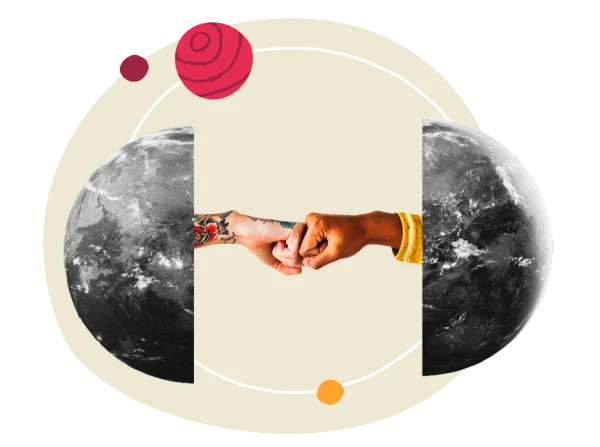What ties us to our coworkers isn’t shared desk space, it’s a shared mission. Although remote work has long been a reality for some, it has become widespread in recent years. Fully remote teams and organizations are now the norm rather than the exception, and remote work isn’t just a perk—it’s an expectation.
With teammates spread across a city, country, and even the globe, HR and business leaders face new communication challenges. How do you adapt a face-to-face culture to fit a newly remote reality? How do you protect engagement, oversight, and high-quality collaboration without time together in the office?
In the past, large global firms typically took a hands-on approach to instilling company culture. In some cases, every new starter spent a week or two at the global headquarters for practical training, gathering company insights and absorbing the culture. It’s no surprise that today organizations are taking a different approach.
That means that HR leaders need to look for reliable ways of setting clear expectations between managers and their team members. From the start, it’s important to define a clear relationship—however distant—that reinforces regular communication between and within teams.
The more information that your people can share about what they’re working on, and what’s happening in any local office—even down to team dinners and culture-building activities—the smaller those global gaps become.
While personal, face-to-face meetings remain the best way of connecting with co-workers and building a stable company culture, there are many ways in which technology can fill the gap. With variable working patterns across a global business, it’s essential to take advantage of these new ways of keeping your teams connected.
Setting up your tech stack
The right tech can really make or break a global culture from both a business and a people perspective. It is your key to seamless communication, clarity, and an engaged culture. Here are some tech tools you should consider:
Videoconferencing
Having the right software and hardware to allow for clear, uninterrupted conversations that don’t drop off halfway through, lose sound, or where calls keep dropping is essential. Keep in mind that your people may also need a stable solution to communicate with your clients and other partners.
At the same time, “Zoom fatigue” is real. Encourage your employees to step away from laptops and take meetings on the go to help them stay engaged and motivated during calls. Consider software that includes a mobile app or “connect via phone” feature, so that your people can take meetings away from their desks when needed.
Internal comms system
An effective internal communication system will give your teams access to all important company messages and information. Consider:
- Using dynamic org charts to show global structures and how everyone in the business links together
- Sharing business, department, and individual goals to provide an overarching view of the bigger picture
- Celebrating birthdays and work anniversaries globally
- Introducing new starters, shouting about successes, and communicating common interests to bring all of your teams together online
On top of that, the platform you choose should allow you to automate HR admin tasks, enable seamless onboarding no matter where your new joiner is located, and provide easy access to company documents. It should be a one-stop shop for creating an engaging company culture no matter where your people work.
Email and messaging tools
Email is an essential tool for any modern business, but in a global setting, it’s important to educate your people on using the scheduling function to ensure emails arrive at an appropriate hour for all time zones. Doing so is courteous and makes everyone in your workforce feel included.
Championing the use of an instant messaging tool such as Slack or Microsoft Teams, which people can snooze when they are out of the office, is another simple, cost-effective way to bridge global gaps and create a true sense of “one team.” This is especially true when these tools integrate with your Human Resource Information System (HRIS) and provide daily updates on what’s happening and where it’s happening.
Virtual water cooler
The office has long been a great place to bring people together, socialize, and build culture. But with people spread across the globe and working in a remote or hybrid work structure, business leaders need to adjust.
Consider using an app like Donut that can be integrated into Slack and which randomly pairs people for a virtual coffee or lunch meeting. This way new joiners (and those who have been around for a while) can meet someone outside of their team and form lasting connections.
In a hybrid work model, a virtual water cooler is an effective way of getting people from different backgrounds and departments to talk, solve problems, and create friendships.
Work globally, play globally
Multi-office competitions and challenges are the perfect way to enhance employee engagement and bring your teams closer together, and technology can help facilitate these.
A simple wellbeing initiative such as seeing which office can do the most steps in one month, which office can build the biggest house of cards, or even which office can drive the most successful charity fundraiser helps build a robust company culture. Consider encouraging the winning office to set and communicate the next challenge, to create meaningful connections and close the global gap.

Choosing the right HR platform for multi-national work
To help your people stay connected, choosing the right HR platform is important. The most effective software brings together all the relevant information your teams need, makes communication easy, and supports an open and communicative global culture.
Look for the following features:
- A global focus, with features for sharing company values and messages throughout your organization, helping you to create tight-knit, interconnected local communities.
- Centralization, so that your org charts, reports, HR business flows, policy documents, and KPIs can all be managed from one single unified platform.
- Localization, with the ability to tailor the platform to support local languages, holiday calendars, currencies, time zones, date formats, and other custom fields you may require.
- Compliance and security features that ensure you uphold local standards regarding sensitive employee information, absence and time-off policies, and other employment practices.
- Reliability, so you know the system will be up and running every time you need it.
Global culture goes beyond tech
While ensuring your people have the right tech for seamless, global communication is key, there are other considerations HR leaders should take into account.
Some of the most common issues that disrupt global operations include:
- Conference or video calls that frequently cut out
- Forgetting remote workers when it comes to team lunches/birthday treats
- Forgetting remote workers more broadly
- In-office jokes that other teams/locations just don’t understand
- Language barriers
- Sarcasm that doesn’t translate
- Time zone issues that have people calling in at 2 am or on national holidays
So how can you create an inclusive culture across your global teams?
- Be aware of time zones. Either use a system that allows your teams to access important messages and information at a time that suits them, or schedule emails to send time-appropriately. Make sure important emails land in inboxes during working hours when they can be discussed.
- Celebrate global festivals across the organization. Widen cultural knowledge, bond, and have fun.
- Clearly communicate international holidays. Prevent global workers from being disturbed on their day off, or meeting times being delayed while you wait for teams that aren’t there to dial in. If you don’t have a system that does this for you, create a team calendar to share which offices are closed.
- Educate everyone on cultural faux pas. Use your HR system to share a PDF guide on the everyday norms of your different global offices. What are the standard greetings? What time do people have lunch? How tactile are they? What is the standard business dress in each of your offices?
- Actions speak louder than words. However, you may have a bi-lingual team and it’s beneficial to learn the absolute basics to help nurture relationships. For example, offering a “hello” or a “thank you” to your colleague in their local language is welcoming, respectful, and inclusive.

Don’t just think multi-national; think multi-cultural
Etiquette at work is a sensitive subject, and as teams become increasingly global, diverse, and multicultural, HR leaders need to support their people to engage with each other in the right ways.
A multi-cultural, global workforce presents huge opportunities for a business, but also a number of challenges. Here are some of the main tripping points to be aware of:
- Different understandings of “on time.” While in the US, a meeting might typically start a few minutes after its scheduled time, in Germany or Japan, this would be seen as late. Equally, in Middle Eastern cultures, even a quarter past could legitimately be considered on time.
- Varying dress codes for work. Similarly, the definition of “formal wear” varies dramatically between different cultures. Help your people get it right and be sensitive to one another by driving open communication and setting clear expectations.
- Humor at work. Appreciation for humor in a business setting also depends on cultural context. Broadly speaking, many in the West associate it with positivity and a creative environment, but people in the East use it far less at work. Help your people be considerate with their tone and language, and appreciate that certain types of humor aren’t always appropriate.
A diverse workforce provides huge benefits for your organization, and building a culture of open and honest communication will encourage your people to learn from each other while also being sensitive to different cultural contexts, helping you overcome remote work challenges.
Recommended For Further Reading
Conclusion
Remote and hybrid work cultures present a whole new set of global workforce challenges for HR leaders. To ensure your people are happy, engaged, and able to do their jobs well, it’s important to develop strong lines of global communication and to invest in technologies that allow for seamless interaction. If you take the time to find company culture advocates across your sites and to set clear expectations for your people and managers, you’ll be headed in the right direction.

Meet Bob
At HiBob, we’ve built a modern HR platform designed for modern business needs—today and beyond.
An HR platform such as Bob offers a one-stop shop for all things HR. It sits at the center of your HR ecosystem, is fully customizable, and grows with your organization.
For HR, it delivers automation of many common processes, allows greater oversight and visibility of the business, and centralizes all people data in a secure, user-friendly environment.
For managers, it provides access to data and insights to help them lead more effectively and streamline processes.
For employees, it’s the tools and information they need to connect, develop, and grow throughout their journey.
In a short time, Bob can be deployed to enable communication, collaboration, and connectivity that drives stronger engagement, productivity, and business outcomes.
